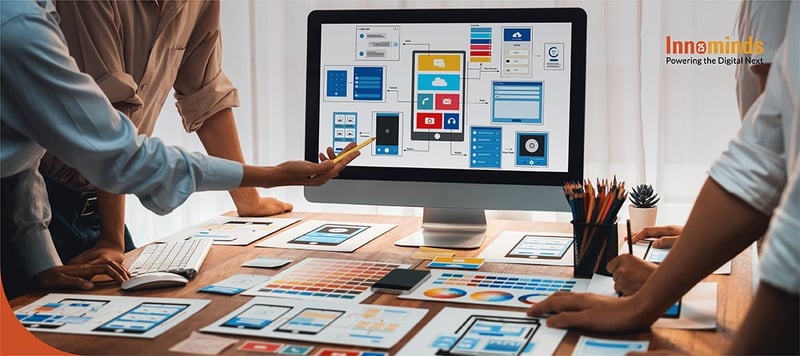
UX and UI engineering intertwine in several aspects – we can’t have one without the other! Customers will get frustrated with your application if the experience or interface is substandard. And then, worse, they’ll simply turn to another offering.
For me, being on a website that doesn’t function properly is definitely a bad user experience, usually due to a poor user interface. The buttons don’t work correctly, I can’t find what I want, and the carousel window is hazardous.
As with so much in life, first impressions are key. Around 94% of the time, a user’s first impression of your website is related to design. Users develop trust and credibility issues with websites that are poorly designed.
Can we resolve this with the help of the latest UI Engineering capabilities?
With the help of UI engineering, we can create valuable user experiences, engage customers and improve web performance. And all of that leads to more revenue! Below are the five top things you can do to make that is possible.
1. Seamless Experience
In the year 2023, this may seem obvious, but you’d be surprised how many organizations don’t provide a consistent excellent experience on different channels, such as web, desktop, mobile, tablet, etc. This helps create an omnichannel experience that makes your application worth users’ time.
We can achieve an omnichannel experience using cross-platform technologies like JavaScript, React, React Native, Angular, Ionic, NativeScript, Svelte, etc.
UX Design is a key method in creating a consistent design experience. To improve your UX design consistency, you can use existing design systems, like Bootstrap, Material UI, Fluent UI, Semantic UI, and Prime, or you can build your own custom design system.
Why is this important? We know that with inconsistent designs, customers don’t know where to go, they can get frustrated and can find the experience confusing. For example, would you revisit the website if the web design works on a computer but needs to be more organized on a mobile screen? Of course not, which brings us to Responsive Web Design (RWD). Thanks to CSS3 for providing media queries, flexbox, and grid layout methods that help create responsive layouts without challenges.
2. Customer Engagement
The best strategy to attract customers is to send proactive notifications about product discounts or relevant information via email or push notifications. Push notifications have higher chances of retaining customers or improving re-sale. Modern browsers support service workers and force managers to implement push notifications without challenges.
People want what they want NOW, or at the very least they want to know WHEN. So, another factor contributing to engagement is page load speed. Evaluate the degree of customers' frustration when the application takes time to load and process data.
We can show a loader or progress bar to update the customer on the situation. However, browsers don't offer the option. JavaScript is single-threaded, and the UI will hang until your data is processed. For such scenarios, it is better to utilize web workers that run in the background thread without interfering with the UI.
In a unique but challenging situation, we may need something to show on a page. For instance, take a product search page. When a search returns zero results, we display "no results found." This leaves the page empty and dull, and we are creating a window of opportunity for the customer to think of options or browse for alternatives.
A viable approach is producing search recommendations using AI/ML technology by building a recommendation engine according to customer interest.
Besides the above methods, conversational chatbots also help engage customers with real-time Q&A. While this reduces wait time and improves the quality of responses, it can also get frustrating for the customer. With proper chatbot implementation, customers may receive appropriate responses or valuable data quickly. Hence, when using chatbots, it is necessary to design them, keeping customer requirements and experience in mind.
3. Experience Enhancements
There’s a good chance customers will stop using your application if they don’t understand the complex UI flows or have a bad interaction experience. So, how can you meet actual (or real) customer expectations?
Creating a smooth and unified customer journey throughout the application is the key. Personalization and collecting customer insights help enhance the outcome of the application or product interactions.
Customer insights involve data about customer behavior, demographics, user system information, etc. Many analytics platforms are available in the market, like Google Analytics, Facebook, etc., which can be integrated into the product. Further, with the help of AI/ML technologies, you can understand customer behavior and refine your application’s UI to meet customer expectations.
We want solutions that save the customer’s time with simplified, complex interactions when considering ease of use.
For example, templatization would help customers save repeated tasks as a template, which allows them to reuse the job next time. Think about, for example, when you need to enter your name and credit card information. Is that fills automatically it makes the experience much better.
Another example is one-click solutions like Amazon providing a one-click button to make purchases with just one click. Yet another example is simplifying the sign-up process by giving a phone number and Time Password (OTP).
Augmented Reality (AR) trails are an excellent example of experience enhancement in e-commerce apps. Customers can try the product in the app itself, including sunglasses, clothes, furniture, etc. Fortunately, all modern browsers support WebAR technology, meaning customers can access the AR experience from their mobile camera and web browser without hassle.
4. Web Performance

Is your web app loading quickly?
Is it smooth and interactive?
If you say 'No' to the above questions, you have a high chance of losing customers. Web performance matters significantly because it helps you with customer retention and high conversion rates.
For instance, making a purchase is an action that is measured as a conversion rate, and a slow application will have an impact on such conversion rates.
To improve performance, the first thing is to minimize the initial load. You can do this by using lazy loading techniques, such as loading only fonts, text, styles, or images visible on the first page. The lazy loading of images and scripts is not used in the initial load.
Another critical point is smooth and faster user interactions. Users get frustrated when the application is lagging or slow.
For example, scrolling interaction would slow down when the content loads into DOM. In such cases, implementing virtual lists would help load only visible content in the browser.
Other than the above, media optimization can also improve performance. Most of the website's content is represented as images and videos, and multimedia content usually takes more bandwidth and memory. The best approach for fast loading of ideas is to use a WebP format that provides better compression than PNG or JPEG.
SVGs also use fewer colors in the image, and these vector graphic formats are responsive and a right fit for different screen resolutions. When we optimize videos, we can save bandwidth and improve web performance.
There are specific tools, like FFmpeg, which optimize and compress videos. Streaming videos also saves bandwidth and improves performance. Adaptive bitrate streaming is a technique used for video streaming over Hypertext Transfer Protocol (HTTP) based on bitrate requests set by the client application.
Lastly, content delivery networks offer potential improvements when you have a geographically distributed customer base. The content would be cached at edge locations and served to the user from the nearest edge location.
5. Accessibility and Localization
Many applications don’t use accessibility and localization, which spoils the experience for some sections of the audience. The world has multiple internet users above 60 years of age or disabled. Considering accessibility and localization for these categories isn’t just the right thing to do, it’s good business. It is essential to connect with people of all ages, physical abilities, and people in rural areas.
For instance, localization would make accessing web content accessible for the broadest range of audiences in regional areas.
There are a few W3C standards or web accessibility norms, and in a few countries, it is mandatory to implement these accessibility standards. Using these standards with dedicated tools, we can improve web accessibility.
Summary
Advanced technologies and engineering capabilities can help us improve the UX according to customer requirements. Providing a better user experience would help in customer retention and business growth.
We at Innominds can bring such user experiences to your applications with our expertise in Experience Engineering.




